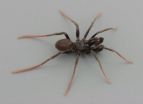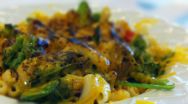(Press-News.org) Embargo: 17 May 2011 18:00 CET
-- The coronary arteries of Princess Ahmose-Meryet-Amon - as visualised by whole body computerised tomography (CT) scanning - will feature in two presentations at the International Conference of Non-Invasive Cardiovascular Imaging (ICNC) this week in Amsterdam (15-18 May). ICNC is now one of the world's major scientific event in nuclear cardiology and cardiac CT imaging.
The Egyptian princess Ahmose-Meryet-Amon, who lived in Thebes (Luxor) between 1580 and 1550 BC and who is now known to be first person in human history with diagnosed coronary artery disease, lived on a diet rich in vegetables, fruit and a limited amount of meat from domesticated (but not fattened) animals. Wheat and barley were grown along the banks of the Nile, making bread and beer the dietary staples of this period of ancient Egypt. Tobacco and trans-fats were unknown, and lifestyle was likely to have been active.
The coronary arteries of Princess Ahmose-Meryet-Amon - as visualised by whole body computerised tomography (CT) scanning - will feature in two presentations at the International Conference of Non-Invasive Cardiovascular Imaging (ICNC) currently taking place in Amsterdam (15-18 May). ICNC is now one of the world's major scientific event in nuclear cardiology and cardiac CT imaging.
Both presentations will be based on findings from the Horus study, in which arterial atherosclerosis was investigated in 52 ancient Egyptian mummies. Results have shown that recognisable arteries were present in 44 of the mummies, with an identifiable heart present in 16. Arterial calcification (as a marker of atherosclerosis) was evident at a variety of sites in almost half the mummies scanned, prompting the investigators to note that the condition was common in this group of middle aged or older ancient Egyptians; the 20 mummies with definite atherosclerosis were older (mean 45.years) than those with intact vascular tissue but no atherosclerosis (34.5 years).
Although relatively common at other vascular sites, atherosclerosis in the coronary arteries was evident in only three of the mummies investigated, but was clearly visualised in Princess Ahmose-Meryet-Amon (in whom calcification was present in every vascular bed visualised).
The CT scan image below shows that the princess, who died in her 40s, had atherosclerosis in two of her three main coronary arteries. "Today," said Dr Gregory S Thomas, director of Nuclear Cardiology Education at the University of California, Irvine, USA, and co-principal investigator of the Horus study, "she would have needed by-pass surgery."
"Overall, it was striking how much atherosclerosis we found," said Dr Thomas. "We think of atherosclerosis as a disease of modern lifestyle, but it's clear that it also existed 3500 years ago. Our findings certainly call into question the perception of atherosclerosis as a modern disease."
If, however, the princess enjoyed a diet deemed to be healthy and pursued a lifestyle probably active, how could this "disease of modern life" affect her so visibly? Dr Thomas and his co-principal investigator Dr Adel Allam of Al Azhar University, Cairo, suggest three possibilities.
First, that there is still some unknown risk factor for cardiovascular disease, or at least a missing link in our understanding of it. Dr Allam noted a likely effect of genetic inheritance, pointing out that much of the human predisposition to atherosclerosis could be secondary to their genes. He similarly raised the possibility that an inflammatory response to the frequent parasitic infections common to ancient Egyptians might predispose to coronary disease - in much the same way that immunocompromised HIV cases seem also predisposed to early coronary disease. Nor can a dietary effect be excluded, despite what we know of life in ancient Egypt. Princess Ahmose-Meryet-Amon was from a noble family, her father, Seqenenre Tao II, the last pharaoh of the 17th Dynasty.
So it's likely that her diet was not that of the common Egyptian. As a royal, she would have eaten more luxury foods - more meat, butter and cheese. Moreover, foods were preserved in salt, which may also have had an adverse effect.
Despite the suggestion of a genetic, inflammatory or unknown effect, Drs Thomas and Allam were keen not to discount those risk factors for heart disease which we do know about. Indeed, even in the study's apparent association of atheroma with increasing age, there was a pattern of prevalence consistent with our own epidemiology today. "Recent studies have shown that by not smoking, having a lower blood pressure and a lower cholesterol level, calcification of our arteries is delayed," said co-investigator Dr Randall C Thompson of the St Luke's Mid-America Heart Institute in Kansas City, USA. "On the other hand, from what we can tell from this study, humans are predisposed to atherosclerosis, so it behoves us to take the proper measures necessary to delay it as long as we can."
INFORMATION:
Most of the Horus study research was performed at the National Museum of Antiquities in Cairo and would not have been possible without the availability of non-invasive CT scanning, the focus of the ICNC congress in Amsterdam. CT scanning and nuclear medicine imaging are the cornerstones of modern quantifiable cardiac disease detection, with safe and reproducible results.
END
OTTAWA – May 17, 2011 – Researchers at the University of Ottawa Heart Institute (UOHI) have identified a novel gene in the nucleus of muscle and brain cells that affects heart development and the aging process. Their investigation brings the promise of new treatments for an old, failing heart.
"We know that aging is the greatest predictor of cardiovascular disease and heart failure. So we have been working backward in time, looking at the fetal heart to understand changes in the process as it ages, grows frail and fails," said molecular biologist Patrick Burgon, PhD. ...
Montreal, May 17, 2011 - Researchers at the CHUM Research Centre (CRCHUM) and the Peter MacCallum Cancer Centre in Australia have identified a new avenue for treating breast cancer.
In 20 to 30% of breast cancer patients, the over-expression of a particular protein (human epidermal growth factor-2) is the main cause of the proliferation of cancer cells. Over the past few years Herceptin® (trastuzumab) has become the standard treatment for this kind of cancer. While it is known that it blocks the activity of this protein, its exact mechanism of action has remained a mystery.
Professor ...
Confused.com has surveyed mums and found that 60% would like to help their children meet the spiralling costs of higher education. With the current annual cost of living and study for a higher education student estimated at around GBP15,500 to GBP16,600* per year, and fees predicted to continue rising, parents may want to consider protecting their children by increasing the term of their life insurance policy.
The research from the car and life insurance comparison website also found that 55% of mums would like to help their children with a deposit for a house (the average ...
A team led by developmental biologist Professor Christophe Marcelle has nailed the mechanism that causes stem cells in the embryo to differentiate into specialised cells that form the skeletal muscles of animals' bodies. The scientists published their results in the British journal Nature on Monday (May 16).
Scientists world wide are racing to pin down the complex molecular processes that cause stem cells in the early embryo to differentiate into specialist cells such as muscle or nerve cells. The field has the potential to revolutionise medicine by delivering therapies ...
A team of researchers from the University of the Free State in South Africa (René Fourie and Charles Haddad) and the Royal Museum for Central Africa in Belgium (Rudy Jocqué) discovered very poorly known purse-web spiders of the genus Calommata in Africa. Four of the species described are new to science. The study was published in the open access journal ZooKeys.
What is really unique about purse-web spiders is that, in contrast to trapdoor spiders, they do not construct a structure to close the burrow. Instead, they build a purse-shaped web of dense silk that covers ...
VaNovo, of MyValera.com, announced today their patent-pending product, Valera, received a USDA Organic Certification, making it the only female lubricant and moisturizer in the World to have a USDA Certified Organic seal of approval.
According to USDA.org, The USDA Organic seal assures consumers of the quality and integrity of organic products. Organic-certified operations must have an organic system plan and records that verify compliance with that plan. Operators are inspected annually in addition there are random checks to assure standards are being met. Organic-certified ...
Spanish researchers from the University of Leon (Nicolás Pérez Hidalgo and M. Pilar Mier Durante) have discovered the plant lice Schizaphis piricola (Matsumura) in Madrid, Spain from a photography displayed on a social network platform: "Biodiversidad Virtual" (http://www.biodiversidadvirtual.org/) (Ángel Umaran). The results have been published recently in the open access journal ZooKeys and are available for free download.
"This discovery is yet another example of how social networks play an important role in our knowledge of biodiversity and the detection and/or monitoring ...
Researchers studying the life threatening infectious disease sepsis have discovered how the infection can lead to a fatal inflammatory response through blood vessel cells. The research, which is published in EMBO Molecular Medicine, focuses on blocking crucial Matrix Metalloprotease enzymes (MMP) which activate the response.
Sepsis, and the associated systemic inflammatory response syndrome (SIRS), is a deadly condition caused by an infection of the blood which leads to whole-body inflammation. The condition is a major cause of death in intensive care wards worldwide ...
Do we buy things because of their attributes, their price, or out of brand loyalty? This was one of the questions asked by researchers from the University of Seville (US), who studied families' behaviour in putting together their shopping basket. They did this by studying their consumption patterns for ground coffee and tomato puree.
"We wanted to know whether there was any similarity in families' behaviour, regardless of the product being bought, and we found that there were certain aspects, such as price sensitivity and brand preference, which could, with a certain ...
If the idea of homemade macaroni and cheese evokes happy memories and makes your tummy growl, you will want to be at The Eatery on Thursday. Co-owners, Don and Cindy Gifford are inviting guests to belly up to their family restaurant's new gourmet mac and cheese bar that features an array of delicious ingredients and an offer to "brown it on top" tableside.
Fans of the comfort food dish will be able to pile on the pasta. Add a favorite grated cheese (cheddar, American, or parmesan). Pick a meat (Virginia baked ham, crumpled bacon, smoked sausage or The Eatery's ...



